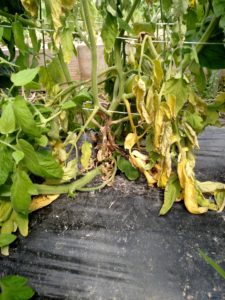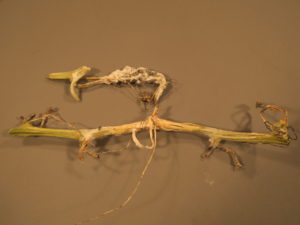White mold has a large host range including tomatoes (where it may be referred to as timber rot), cucumbers, lettuce and snap beans as well as many more. In this article, I will concentrate on white mold on tomatoes in a greenhouse situation. Although white mold will occur in a field situation, this disease is more common in a greenhouse due to the higher relative humidity than in a field situation.
Perhaps the most common symptom of white mold of tomato is the light brown area on the lower stem (Figure 1 and 2). This brown area is essentially dead and will result in the wilt and death of the plant above that point. Either on the outside of this dead area or inside the stem, dark, irregularly shaped fungal bodies can usually be found. These fungal bodies (known as sclerotia) are diagnostic of white mold.

Figure 1. White mold or timber rot of tomato causes a light brown area on the stem and a wilt of the plant.

Figure 2. The stem and small fruit of a cucumber plant after incubation in a plastic bag with a wet paper towel. Note dark fungal bodies known as sclerotia.
Recently, I had a complaint of severe white mold of tomato in a high tunnel. The grower reported that white mold of lettuce was found in the field last year about 50 feet from the high tunnel. The grower wanted to know how the white mold made its way from last year’s lettuce to this year’s tomatoes.
The fungus that causes white mold survives from year to year by the sclerotia that drop to the soil. Most likely, sclerotia dropped to the soil in the lettuce field. These fungal bodies then produced very small mushrooms this spring. The spores from this mushroom can drift in the wind as much as 300 feet. When the spores land on a leaf or flower petal, they may survive for several weeks. Successful infections tend to result from spores that land on old senescent tissue such as flower petals or older leaves.
It is possible that soil from the lettuce field was tracked into the high tunnel. If the soil included sclerotia, then a small mushroom could have been produced. (The mushrooms that are produced from sclerotia are very small and unlikely to be observed).
Anything that can be done to minimize relative humidity and leaf moisture will help reduce the severity of white mold. Therefore, vent the greenhouse in the evening (if possible) and space the tomato plants far enough apart to allow air circulation. A good rule of thumb is to leave 5 feet between rows and 20 inches between determinant tomato plants.
A biological control is available for white mold. The product, known as Contans®, has an active ingredient that is a fungus that parasitizes the white mold fungus. Contans® is usually added to the soil the fall before planting. In the case described above, If Contans® had been added to the lettuce field in the fall, the sclerotia may have been prevented from forming mushrooms. However, the mushrooms were produced in an area that didn’t receive Contains®, then there would have been no control. It may not be effective for greenhouse growers to treat the ground in a greenhouse with Contans if the spores are coming in from outside. For more information about Contans®, read the label and/or see the Midwest Vegetable Production Guide for Commercial Growers 2017, also known as the ID-56 mwveguide.org.
Another strategy for minimizing the severity of white mold is to keep an area around the greenhouse free from weeds. At the Southwest Purdue Agriculture Center (SWPAC) we have spread gravel for at least 50 feet in all directions from our high tunnels. Under the gravel, we have placed a weed barrier. I believe that this practice has helped to reduce white mold in our tunnels. However, we still observe white mold.
At SWPAC, in order to minimize disease, use weed barrier between rows. Diseased plant residue (such as tomato stems with sclerotia), if it does fall to the ground, can easily be swept up and discarded well away from any crop production area.
Products that may be applied to the foliage for control of white mold of tomato are limited. Actinovate AG® is listed in the ID-56 and may be applied in the greenhouse. Cabrio EG® and Priaxor® are listed for white mold of tomato, but may not be used in the greenhouse.